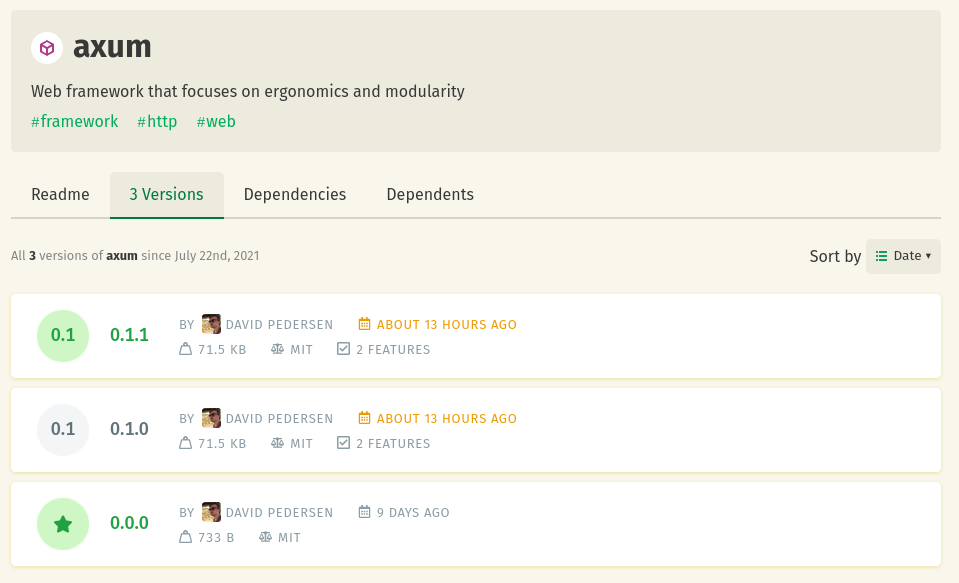Rustの新しいWEBフレームワークaxumを触ってみた
axum version0.2.0 is released!!
本日2021-08-24、axum version0.2.0がリリースされました。
この記事のコードを参考にする場合はバージョンによる違いに注意してください。
2021-08-14追記
axum 0.1.2, 0.1.3のリリースによりこの記事の一部の記述は古いものとなりました。
この記事に関わる変更は以下です。
- 多くのextractorが
Derefを実装した -
axumがhyper::Serverをre-exportするようになった -
extract::UrlParamsとextract::UrlParamsMapが非推奨となり、extract::Pathが推奨されるようになった
axum 0.1.3対応版のコードは https://github.com/techno-tanoC/axum_sample/tree/680a5aad51a1b0302910bade890ad82aaf069fda にあります。
追記
Zenn公式ツイッターにピックアップされました!ありがとうございます!
追記ここまで
axum
日本時間本日、tokioからAxumというWEBフレームワークがアナウンスされました。
( リリースされて13時間のできたてホヤホヤの図 )

crates.ioのREADMEによると「エルゴノミックでモジュラー性にフォーカスしたWEBアプリケーションフレームワーク」だそうです。公式のアナウンスによると「tokioのエコシステムの利点をフル活用できる」とのことです。tokioのお膝下で作られているだけあって期待できます。
他にも以下の特徴が挙げられています。
- マクロのないAPIでルーティングができる
- 宣言的なリクエストのパース
- シンプルで予測可能なエラーハンドリング
- 最小限のボイラープレートでレスポンスを作れる
-
towerとtower-httpのエコシステムをフル活用できる
サンプルを見た感じ、クセが少なく「こういうので良いんだよ、こういうので」という印象を持ったので早速触ってみました。
コード全体は https://github.com/techno-tanoC/axum_sample/tree/91a5b870c9bbc149ea533a3ec78154b8c202de46 のexamplesにあります。
Hello World!
何はともあれ公式に載っているHello Worldを試してみます。
[package]
name = "axum_sample"
version = "0.1.0"
edition = "2018"
# See more keys and their definitions at https://doc.rust-lang.org/cargo/reference/manifest.html
[dependencies]
axum = "0.1.1"
hyper = { version = "0.14", features = ["full"] }
tokio = { version = "1", features = ["full"] }
hyper と tokio のfeaturesはサボって full にしています。
use axum::prelude::*;
use std::net::SocketAddr;
#[tokio::main]
async fn main() {
let app = route("/", get(root));
let addr = SocketAddr::from(([127, 0, 0, 1], 3000));
hyper::Server::bind(&addr)
.serve(app.into_make_service())
.await
.unwrap();
}
async fn root() -> &'static str {
"Hello, World!"
}
当然のようにハンドラが async で嬉しくなりますね。
$ curl http://localhost:3000/
Hello, World!
文字列を返すハンドラは文字列をそのまま content-type: text/plain で返すようです。
よさそう
JSON API
続いてはJSONを受け取ってJSONを返すAPIを作ってみます。
今回は簡単に「受け取ったカウントに1を足して返すAPI」を作ってみます。
依存ライブラリに serde を追加しておきます。
use axum::{
extract,
response,
prelude::*,
};
use serde::{Serialize, Deserialize};
use std::net::SocketAddr;
#[tokio::main]
async fn main() {
let app = route("/ping", post(ping));
let addr = SocketAddr::from(([127, 0, 0, 1], 3000));
hyper::Server::bind(&addr)
.serve(app.into_make_service())
.await
.unwrap();
}
#[derive(Deserialize)]
struct Ping {
count: i64,
}
#[derive(Serialize)]
struct Pong {
count: i64,
}
async fn ping(extract::Json(ping): extract::Json<Ping>) -> response::Json<Pong> {
response::Json(Pong {
count: ping.count + 1,
})
}
リクエストは axum::extract::Json 、レスポンスは axum::response::Json を使うようです。それぞれserdeの Deserialize と Serialize を実装していれば良いようなので、非常に楽ですね。
$ curl -H 'Content-Type: application/json' -d '{"count": 0}' http://localhost:3000/ping
{"count":1}
$ curl -H 'Content-Type: application/json' -d '{"count": 3}' http://localhost:3000/ping
{"count":4}
ちゃんと動いています。
パスパラメータ
use axum::{
extract,
response,
prelude::*,
};
use serde::{Serialize, Deserialize};
use std::net::SocketAddr;
#[tokio::main]
async fn main() {
let app = route("/users/:user_id/posts/:post_id", get(user_post));
let addr = SocketAddr::from(([127, 0, 0, 1], 3000));
hyper::Server::bind(&addr)
.serve(app.into_make_service())
.await
.unwrap();
}
async fn user_post(extract::UrlParams(params): extract::UrlParams<(u64, u64)>) -> String {
let user_id = params.0;
let post_id = params.1;
format!("user_id: {}, post_id: {}", user_id, post_id)
}
axum::extract::UrlParams を使えば良いようです。
パスパラメータがタプルになっているのでインデックスでアクセスします。
$ curl http://localhost:3000/users/1/posts/2
user_id: 1, post_id: 2
UrlParamsMap を使えばハッシュマップのように扱うこともできるっぽいですが、引数部分で型を明示できる UrlParams の方がシンプルなケースでは良さそうです。
パスパラメータ+JSON API
extractorはハンドラの引数部分でそのまま組み合わせられます。
パスパラメータで user_id 、JSONで name を受け取ってメッセージをJSONで返すAPIを作ってみました。
use axum::{
extract,
response,
prelude::*,
};
use serde::{Serialize, Deserialize};
use std::net::SocketAddr;
#[tokio::main]
async fn main() {
let app = route("/users/:user_id", post(user_message));
let addr = SocketAddr::from(([127, 0, 0, 1], 3000));
hyper::Server::bind(&addr)
.serve(app.into_make_service())
.await
.unwrap();
}
#[derive(Deserialize)]
struct Name {
name: String,
}
#[derive(Serialize)]
struct Message {
message: String,
}
async fn user_message(
extract::UrlParams(params): extract::UrlParams<(u64,)>,
extract::Json(name): extract::Json<Name>,
) -> response::Json<Message> {
let user_id = params.0;
let name = name.name;
response::Json(Message {
message: format!("Hello {}, your id is {}", name, user_id),
})
}
$ curl -H 'Content-Type: application/json' -d '{"name": "techno"}' http://localhost:3000/users/1
{"message":"Hello techno, your id is 1"}
パスパラメータ、クエリパラメータ、ヘッダー、Bodyなどから、欲しいextractorを引数部分に書くだけなので非常に楽です。 Option 型で包めばオプショナルなリクエストパラメータを扱うこともできます。
FromRequest
FromRequest というのを実装すればカスタムextractorを作れます。
from_request という名前の関数を検索するといくつかヒットし、それらを組み合わせてカスタムextractorを定義できるようです。 https://docs.rs/axum/0.1.1/axum/extract/index.html#defining-custom-extractors
MultipartQueryFormJsonExtensionBodyStreamBodyContentLengthLimitUrlParamsMapUrlParamsTypedHeaderRawQueryRequest
1つ上で作ったパスパラメータ+JSONのカスタムextractorを実装してみます。
依存ライブラリに http http-body serde_json tower を追加。
use axum::{
async_trait,
extract::{self, FromRequest, RequestParts},
prelude::*,
response::{self, IntoResponse},
};
use http::Response;
use serde::{Deserialize, Serialize};
use std::net::SocketAddr;
use tower::BoxError;
#[tokio::main]
async fn main() {
let app = route("/users/:user_id", post(user_message));
let addr = SocketAddr::from(([127, 0, 0, 1], 3000));
hyper::Server::bind(&addr)
.serve(app.into_make_service())
.await
.unwrap();
}
#[derive(Deserialize)]
struct Params {
user_id: u64,
name: String,
}
#[async_trait]
impl<B> FromRequest<B> for Params
where
B: Send + http_body::Body,
B::Data: Send,
B::Error: Into<BoxError>,
{
type Rejection = Response<Body>;
async fn from_request(req: &mut RequestParts<B>) -> Result<Self, Self::Rejection> {
let url_params = extract::UrlParamsMap::from_request(req)
.await
.map_err(IntoResponse::into_response)?;
let user_id = url_params
.get_typed("user_id")
.unwrap()
.unwrap();
let json_params: extract::Json<serde_json::Value> = extract::Json::from_request(req)
.await
.map_err(IntoResponse::into_response)?;
let name = json_params.0.get("name")
.unwrap()
.as_str()
.unwrap();
Ok(Params {
user_id: user_id,
name: name.to_string(),
})
}
}
#[derive(Serialize)]
struct Message {
message: String,
}
async fn user_message(
params: Params
) -> response::Json<Message> {
let user_id = params.user_id;
let name = params.name;
response::Json(Message {
message: format!("Hello {}, your id is {}", user_id, name),
})
}
unwrap でエラーハンドリングをサボっています。すみません。
$ curl -H 'Content-Type: application/json' -d '{"name": "techno"}' http://localhost:3000/users/1
{"message":"Hello techno, your id is 1"}
また、 Rejection を上手く使うことで from_request 内でバリデーションや柔軟なエラーレスポンスの構築ができる気がします( 未検証 )
状態
layer と AddExtensionLayer を使うことで状態を持つことができるようです。
依存ライブラリに tower-http を追加。
アクセスする度にカウンタが増えていくAPIを作ってみました。
use axum::{
extract,
prelude::*,
response,
};
use serde::{Serialize, Deserialize};
use std::net::SocketAddr;
use std::sync::Arc;
use tokio::sync::Mutex;
use tower_http::add_extension::AddExtensionLayer;
#[tokio::main]
async fn main() {
let state = Arc::new(Mutex::new(State { counter: 0 }));
let app = route("/", get(increment))
.layer(AddExtensionLayer::new(state));
let addr = SocketAddr::from(([127, 0, 0, 1], 3000));
hyper::Server::bind(&addr)
.serve(app.into_make_service())
.await
.unwrap();
}
#[derive(Serialize, Deserialize)]
struct State {
counter: i64,
}
type SharedState = Arc<Mutex<State>>;
async fn increment(extract::Extension(state): extract::Extension<SharedState>) -> response::Json<State> {
let mut s = state.lock().await;
s.counter += 1;
let current = s.counter;
response::Json(State { counter: current })
}
$ curl http://localhost:3000/
{"counter":1}
$ curl http://localhost:3000/
{"counter":2}
$ curl http://localhost:3000/
{"counter":3}
公式のexampleにはPostgresのConnectionPoolを状態として持つものも紹介されています。 https://github.com/tokio-rs/axum/blob/main/examples/tokio_postgres.rs
レスポンス
&'static str や axum::response::Json 以外にも axum::response::IntoResponse を実装したものであればなんでもレスポンスとして返せます。
デフォルトでは文字列系の型、バイト列系の型、ステータスコード、ヘッダー、 Json 、 Html 、(StatusCode, HeaderMap, IntoResponse) 辺りに実装されているようです。
今回は (StatusCode, HeaderMap, &'static str) を返してみました。
use axum::prelude::*;
use http::{HeaderMap, StatusCode};
use std::net::SocketAddr;
#[tokio::main]
async fn main() {
let app = route("/", get(response));
let addr = SocketAddr::from(([127, 0, 0, 1], 3000));
hyper::Server::bind(&addr)
.serve(app.into_make_service())
.await
.unwrap();
}
async fn response() -> (StatusCode, HeaderMap, &'static str) {
let mut headers = HeaderMap::new();
headers.isert("x-hello", "world".parse().unwrap());
(StatusCode::CREATED, headers, "created")
}
$ curl -v http://localhost:3000/
* Trying 127.0.0.1:3000...
* Connected to localhost (127.0.0.1) port 3000 (#0)
> GET / HTTP/1.1
> Host: localhost:3000
> User-Agent: curl/7.78.0
> Accept: */*
>
* Mark bundle as not supporting multiuse
< HTTP/1.1 201 Created
< x-hello: world
< content-length: 7
< date: Sat, 31 Jul 2021 09:03:04 GMT
<
* Connection #0 to host localhost left intact
created
良い感じ。
その他の機能
今回は動かしていませんが、公式のサンプルにあった機能を見てみました。
- Form: https://github.com/tokio-rs/axum/blob/main/examples/form.rs
-
Deserializeを実装していればaxum::extract::Formで受け取れるようです。
-
- multipart form: https://github.com/tokio-rs/axum/blob/main/examples/multipart_form.rs
-
axum::extract::Multipartで受け取れる -
ContentLengthLimitを使うことでデータの大きさを制限して受け取れそう -
ContentLengthLimitは他のリクエストパラメータと組み合わせて使えそう
-
- ファイル配信: https://github.com/tokio-rs/axum/blob/main/examples/static_file_server.rs
-
tower_httpのServeDirを使うことができる
-
- Templating: https://github.com/tokio-rs/axum/blob/main/examples/templates.rs
- exampleではaskamaを使っている
-
IntoResponseを実装すれば他のテンプレートエンジンも使えそう
- websocket: https://github.com/tokio-rs/axum/blob/main/examples/websocket.rs
所感
- 全体的に記述が直感的
- 公式ドキュメントやexamplesを見れば使い方がおおよそ分かり、学習コストが低いように感じました。(
rocketやwarpなどの類似のフレームワークを触ったことがあるからかもしれませんが ) -
rocketやwarpと比べてもクセが少ないように感じます - 個人的によく使う機能( リクエストパラメータ、JSON、ヘッダ、状態管理辺り )がよくまとまっていて使い勝手が良い印象
-
FromRequestとRejectionでカスタムextractorを作る部分はやや独特かも
- 公式ドキュメントやexamplesを見れば使い方がおおよそ分かり、学習コストが低いように感じました。(
- リクエスト、ハンドラ、レスポンスの仕組みがシンプルかつ柔軟
- 基本的なリクエストパラメータの扱いが非常に簡単
- 今までは
rocketが一番リクエストパラメータの扱いが楽だと思っていたのですが、axumはそれと同等以上だと思いました - 複雑なリクエスト、レスポンスの扱いも
FromRequest、IntoResponseを実装すればいけます
- tokioの下で作られているので比較的安心して使い続けられる
- コンパイルエラーのメッセージがやや分かりにくい
-
the trait bound `hyper::common::exec::Exec: hyper::common::exec::ConnStreamExec<RouteFuture<axum::handler::OnMethod<IntoService<fn(UrlParams<(u64,)>, std::option::Option<axum::extract::Json<Name>>) -> impl Future {user_message}, hyper::Body, _>, EmptyRouter>, EmptyRouter, hyper::Body>, http_body::combinators::box_body::BoxBody<hyper::body::Bytes, BoxStdError>>` is not satisfiedみたいな長いエラーが何個も出てきて何が問題なのかパッと見では分からないことがありました - まぁこれはrustあるあるなので
axumに限った話ではないです
-
まとめ
- tokio, hyper, towerをフル活用した新しいWEBフレームワーク
axumがリリースされた - 既存のWEBフレームワークと比べてクセが少なく使い勝手が良さそう & 学習コストが低そう
-
tokio+hyperをベースにしたWEBフレームワークの中では、axumが デファクトスタンダードになっていく気がする
Discussion